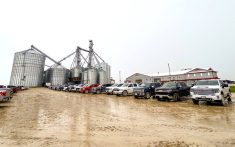Canadian canola farmers find themselves in a tough spot this spring as the snow disappears and they look across those vast empty fields, many of which, under normal circumstances, would be boasting pretty yellow flowers by mid-July.
Canola surpassed wheat a few years back as the largest contributor to farm cash receipts from crops by a fairly large margin. So the potential impact of China’s decision — Canada’s largest canola customer — to essentially stop buying this past month is worrisome.
Read Also

Footflats Farm recognized with Ontario Sheep Farmers’ DLF Pasture Award
Gayla Bonham-Carter and Scott Bade, of Footflats Farm, win the Ontario Sheep Farmers’ 2025 DLF Ontario Pasture Award for their pasture management and strategies to maximize production per acre.
Why it matters: Farmers could be left scrambling for profitable crops to grow this summer if canola exports to China do not return.
Is this a case of petulant grandstanding that will blow over in a few weeks? Or is it the start of a prolonged trade dispute? Or, are we seeing a fundamental shift in consumption patterns? Speculation abounds.
In the meantime, do farmers stick to their planting plans? Or do they trim acres back and use this growing season to rebalance their crop rotations?
Economists Al Mussell, Doug Hedley and Ted Bilyea with the Guelph-based Agri-Food Economic Systems research group have published a paper that outlines why it is so hard to make decisions in the current market environment.
Put simply, there are so many variables in play right now, there is no way of predicting how it’s going to go. That throws a wrench into economic theory about market equilibrium.
“The worry as of early spring 2019… is that there is little clarity or stability in envisioning the ‘expected equilibrium’ in the fall for field crops that will be planted in the next two months in Canada, U.S. and other northern hemisphere countries. Nor is there clarity in the livestock markets. And neither is there clarity in the trade arrangements that will exist when crops are harvested this fall or livestock are marketed from breeding decisions made this spring,” they wrote.
China looms large on all fronts, partly due to its ongoing trade dispute with the U.S. and its emerging one with Canada. But it is also facing a major epidemic of African swine fever, which could significantly cut into its pork production capacity — potentially increasing its demand for meat and reducing its demand for feed commodities.
The possibility exists that for the foreseeable future, this turbulence is the new normal as a rather large emerging economy exercises its marketplace might.
“Another possibility is that the turmoil is sufficiently severe that it causes businesses and countries to move on from the past conditions that characterized the old equilibrium. In this case, there is no reversion back to the old norm and the situation governing the market is forever changed,” the economists say.
Regardless of the reason for China’s withdrawal from purchases and despite the calls on the federal government to send a delegation over to knock some sense into them, there is really nothing anyone can do to force China to buy our canola.
The real issue is the sector’s vulnerability to such marketplace shenanigans. The main reason China can throw Canada’s canola sector into crisis — essentially kicking the Canadian government where it hurts — is that it is such a dominant buyer, taking 43 per cent of the canola we export.
Canadian Grain Commission statistics show that in the 2017-18 crop year, Canada sold 10.237 million tonnes of canola to 11 countries. China and Japan accounted for 63.5 per cent of those sales.
By comparison, Canada sold 16.2 million tonnes of wheat to 53 countries. Our largest export customer, Indonesia, bought just under 1.7 million tonnes, accounting for 10.4 per cent of those purchases. In fact, our top three customers each come in around the 10 per cent mark for sales. As Canada’s fourth largest export wheat customer, China’s purchases accounted for 6.5 per cent of sales.
Any of our top wheat customers could walk tomorrow and the sector would barely skip a beat.
So, is China really the cause of Canadian canola pain right now, or is it symptomatic of our lack of canola customer diversity?
The federal government may have to step in to support farmers through this mess. But over the long term, the focus needs to be on improving the sector’s marketplace resilience.















